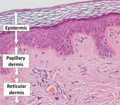Dermoepidermal junction
Dermoepidermal Junction
The dermoepidermal junction (DEJ) is a critical structure within the skin that serves as the interface between the epidermis and the dermis. This complex structure plays a pivotal role in maintaining skin integrity, facilitating nutrient exchange, and supporting the skin's mechanical resistance. Understanding the DEJ is essential for comprehending various skin diseases and conditions, as well as for the development of dermatological treatments.
Structure and Function[edit]
The dermoepidermal junction is composed of a basal lamina that separates the epidermis from the dermis. This lamina is further divided into two layers: the lamina lucida and the lamina densa. The DEJ's structure is reinforced by anchoring fibrils, primarily composed of collagen VII, which extend into the dermis, providing mechanical support and stability to the skin.
The primary function of the DEJ is to anchor the epidermis to the dermis, preventing the two layers from shearing apart under mechanical stress. Additionally, the DEJ facilitates the exchange of nutrients and waste products between the epidermis and dermis. It also plays a crucial role in the skin's repair process following injury.
Clinical Significance[edit]
Alterations or damage to the dermoepidermal junction can lead to a variety of skin disorders. For example, autoimmune diseases such as bullous pemphigoid target proteins within the DEJ, leading to blistering and skin fragility. Similarly, mutations affecting the genes encoding for components of the DEJ can result in genetic disorders like epidermolysis bullosa, characterized by extreme skin fragility and blistering.
Understanding the DEJ is also vital for dermatological and cosmetic procedures, including laser therapy and skin grafting. Knowledge of this junction helps in minimizing damage and promoting effective healing.
Research and Developments[edit]
Recent advances in molecular biology and microscopy have allowed for a deeper understanding of the DEJ's composition and function. Studies focusing on the regeneration of the DEJ are particularly promising for improving outcomes in wound healing and in the treatment of degenerative skin diseases. Furthermore, research into the DEJ's role in skin aging and cancer metastasis is ongoing, with the potential to inform new therapeutic strategies.
Conclusion[edit]
The dermoepidermal junction is a fundamental component of the skin, essential for its structural integrity and function. Ongoing research into its complex structure and role in disease processes holds promise for the development of novel dermatological treatments.
Dermoepidermal junction[edit]
-
Epidermis, papillary dermis and reticular dermis
Ad. Transform your life with W8MD's Budget GLP-1 injections from $75


W8MD offers a medical weight loss program to lose weight in Philadelphia. Our physician-supervised medical weight loss provides:
- Weight loss injections in NYC (generic and brand names):
- Zepbound / Mounjaro, Wegovy / Ozempic, Saxenda
- Most insurances accepted or discounted self-pay rates. We will obtain insurance prior authorizations if needed.
- Generic GLP1 weight loss injections from $75 for the starting dose.
- Also offer prescription weight loss medications including Phentermine, Qsymia, Diethylpropion, Contrave etc.
NYC weight loss doctor appointmentsNYC weight loss doctor appointments
Start your NYC weight loss journey today at our NYC medical weight loss and Philadelphia medical weight loss clinics.
- Call 718-946-5500 to lose weight in NYC or for medical weight loss in Philadelphia 215-676-2334.
- Tags:NYC medical weight loss, Philadelphia lose weight Zepbound NYC, Budget GLP1 weight loss injections, Wegovy Philadelphia, Wegovy NYC, Philadelphia medical weight loss, Brookly weight loss and Wegovy NYC
|
WikiMD's Wellness Encyclopedia |
| Let Food Be Thy Medicine Medicine Thy Food - Hippocrates |
Medical Disclaimer: WikiMD is not a substitute for professional medical advice. The information on WikiMD is provided as an information resource only, may be incorrect, outdated or misleading, and is not to be used or relied on for any diagnostic or treatment purposes. Please consult your health care provider before making any healthcare decisions or for guidance about a specific medical condition. WikiMD expressly disclaims responsibility, and shall have no liability, for any damages, loss, injury, or liability whatsoever suffered as a result of your reliance on the information contained in this site. By visiting this site you agree to the foregoing terms and conditions, which may from time to time be changed or supplemented by WikiMD. If you do not agree to the foregoing terms and conditions, you should not enter or use this site. See full disclaimer.
Credits:Most images are courtesy of Wikimedia commons, and templates, categories Wikipedia, licensed under CC BY SA or similar.
Translate this page: - East Asian
中文,
日本,
한국어,
South Asian
हिन्दी,
தமிழ்,
తెలుగు,
Urdu,
ಕನ್ನಡ,
Southeast Asian
Indonesian,
Vietnamese,
Thai,
မြန်မာဘာသာ,
বাংলা
European
español,
Deutsch,
français,
Greek,
português do Brasil,
polski,
română,
русский,
Nederlands,
norsk,
svenska,
suomi,
Italian
Middle Eastern & African
عربى,
Turkish,
Persian,
Hebrew,
Afrikaans,
isiZulu,
Kiswahili,
Other
Bulgarian,
Hungarian,
Czech,
Swedish,
മലയാളം,
मराठी,
ਪੰਜਾਬੀ,
ગુજરાતી,
Portuguese,
Ukrainian

